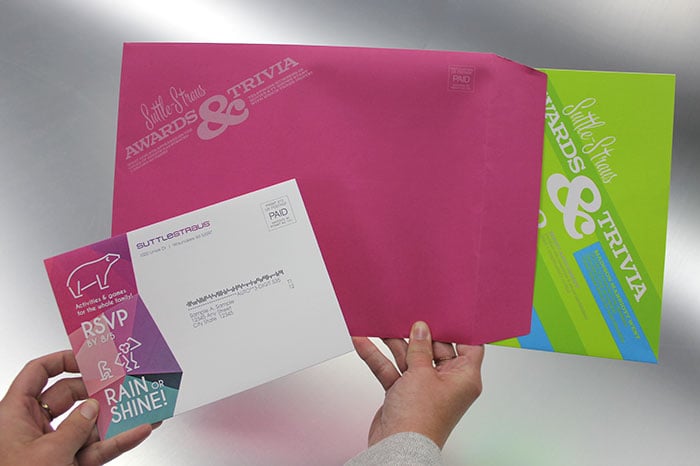
There are many ways to send direct mail pieces – from flat envelopes to a standard letter sized mailer, a postcard or a dimensional piece. The format your mailer takes will depend on a number of factors, including your marketing objective, the product or service you're promoting, the audience, and your budget.
The table below shows a breakdown of some of the determining factors that may influence your mailer towards either a letter mailer (something that mails in an envelope) or self-mailer format (anything that is mailed without an envelope). Keep in mind that this is just a general guideline, ultimately, the decision is dependent on your goals for the piece. Knowing the history of what’s worked well in past campaigns can also play a big part in this decision.
| Letter | Self-Mailer | |
| Objective | Sell a product or service, build rapport | Build brand awareness, send reminders |
| Product/ Service |
More complex, longer sales cycle | Simple, easy to explain |
| Audience | Established relationships or desire to build long-term relationships | May be warm or cold leads, often sent out to a larger audience |
| Budget | Typically higher cost, depending on number of components | Can be done relatively cost-effective, depending on format |
In addition to aligning the format with your goals, consider the pros and cons to each mail option:
| Letter | Self-Mailer | |
| Pros |
Generally, more personalized The piece and/or brand may be more familiar to the reader Can include multiple inserts/collateral |
Are often more visually interesting May get shared more because they aren’t personalized Usually cheaper to produce |
| Cons |
May be more costly Usually not as attention getting Can get lost in the clutter of other letters |
Can have a limited amount of space for communicating the message The message may get lost in the splashy-ness of the graphics |
Once you know what type of mailer you’ll need for your campaign, you can begin the design. If creating a self-mailer, consider adding additional space and visual interest by turning it into a folded self-mailer.
Folded Self-Mailers
By definition, a folded self-mailer (FSM) is a mail piece that has space for a name, address and postage, and can be mailed without a wrapper or envelope. A FSM is comprised of a number of panels that are folded to create a rectangle or square.
The following fold methods are the most common:
- Bi-fold – This fold is simply a single sheet folded once in half, forming two panels.
- Tri-fold – Like a tri-fold brochure, this is a single sheet folded two times to create three panels.
- Quarter fold – This fold is accomplished by folding one sheet two times, with the second fold at a right angle from the preceding fold, thus creating four panels.
- Oblong – In this fold, the sheet is often seen as the width of a letter and folded vertically.
There are other folding combinations that could be used in a self-mailer design, such as a gate fold or roll fold, as long as the mailer follows the requirements set forth by the USPS in regards to height, length, thickness, weight, and sealing method.
In the end, you want a beautiful direct mail piece that will stand out, clearly communicate you message, and will encourage the recipient to take action. Ensuring that you choose the right format is just one piece that may determine the success of the campaign.
For other ways to improve the ROI of your direct mail campaigns, check out these related articles:



